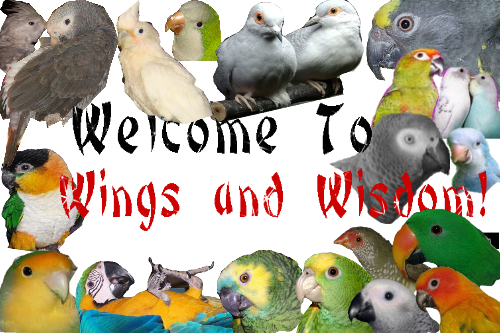The Great Alexandrian Parakeet
Page 1 of 1
 The Great Alexandrian Parakeet
The Great Alexandrian Parakeet
This is on my top 5 list. I have 3 of them and they are a great bird. You need to know that this is the largest of the parakeet family and they have a very very hard bite. They will not usually use their bite but if needed they will not hesitate to put a good one on you. This bird is not recomended by me for small children. They move way to quick and can spook this bird very easy. There beak size and pressure will really hurt the small fingers. Please fully supervise this bird with your children.
Animal Description: Breed Standard
The Alexandrine Parakeet, also known as the Alexandrine Parrot, is one of the most interesting and entertaining birds to keep as a pet. They are well known for their excellent mimicking skills and are capable of learning to mimic any voice or sound.
Alexandrine Parakeets are playful mimics. In captivity, they enjoy swinging on a perch or napping. Alexandrine Parakeets can be very affectionate towards their keepers. They are excellent actors and can learn to mimic almost any sound they hear nearly flawlessly. In the wild, Alexandrine Parakeets feed primarily on fruits and seeds. Alexandrine Parakeets can live to be 40 years old, or older with proper care.
The very long tail of the Alexandrine Parakeet can reach up to fourteen inches in length. The males of the species generally have a black and rose ring around the neck and birds of both sexes have maroon patches on their wings.
Found natively throughout Southern India and Sri Lanka, the Alexandrine Parakeet was first imported to Europe in the 15th century. They are named after Alexander the Great, who is rumored to have been one of the first people to export parrots from Asia to Europe. Alexandrine Parakeets were considered a sign of status among the Romans and were very popular as gifts from returning explorers.
Specific Care Information: Relative Care Ease: Average
Alexandrine Parakeets should be provided with a rather tall cage, they need space for climbing. The cage should also be plenty wide as well, providing plenty of room for your bird to stretch his wings. They enjoy chewing and should be provided with suitable toys. Alexandrine Parakeets should be fed a diet of fruits and vegetable as well as commercially bought pellets.
Breeding and Propagation: Relative Breeding Ease: Uncertain
Breeding Alexandrine Parakeets is relatively easy. It has been reported that this species has only one clutch each year with an incubation time of approximately 28 days. Clutch size usually averages between 3 to 4. The first one will tend to hatch after 28 days and the others tend to hatch later as the feeding cries of the first chick is heard.
Animal Description: Breed Standard
The Alexandrine Parakeet, also known as the Alexandrine Parrot, is one of the most interesting and entertaining birds to keep as a pet. They are well known for their excellent mimicking skills and are capable of learning to mimic any voice or sound.
Alexandrine Parakeets are playful mimics. In captivity, they enjoy swinging on a perch or napping. Alexandrine Parakeets can be very affectionate towards their keepers. They are excellent actors and can learn to mimic almost any sound they hear nearly flawlessly. In the wild, Alexandrine Parakeets feed primarily on fruits and seeds. Alexandrine Parakeets can live to be 40 years old, or older with proper care.
The very long tail of the Alexandrine Parakeet can reach up to fourteen inches in length. The males of the species generally have a black and rose ring around the neck and birds of both sexes have maroon patches on their wings.
Found natively throughout Southern India and Sri Lanka, the Alexandrine Parakeet was first imported to Europe in the 15th century. They are named after Alexander the Great, who is rumored to have been one of the first people to export parrots from Asia to Europe. Alexandrine Parakeets were considered a sign of status among the Romans and were very popular as gifts from returning explorers.
Specific Care Information: Relative Care Ease: Average
Alexandrine Parakeets should be provided with a rather tall cage, they need space for climbing. The cage should also be plenty wide as well, providing plenty of room for your bird to stretch his wings. They enjoy chewing and should be provided with suitable toys. Alexandrine Parakeets should be fed a diet of fruits and vegetable as well as commercially bought pellets.
Breeding and Propagation: Relative Breeding Ease: Uncertain
Breeding Alexandrine Parakeets is relatively easy. It has been reported that this species has only one clutch each year with an incubation time of approximately 28 days. Clutch size usually averages between 3 to 4. The first one will tend to hatch after 28 days and the others tend to hatch later as the feeding cries of the first chick is heard.

 Similar topics
Similar topics» Indian Ringneck Parakeet
» Quakers in Washington
» this is a great forum!
» Wishing great success
» Great Quaker info
» Quakers in Washington
» this is a great forum!
» Wishing great success
» Great Quaker info
Page 1 of 1
Permissions in this forum:
You cannot reply to topics in this forum
